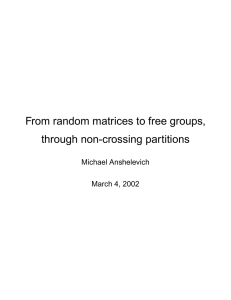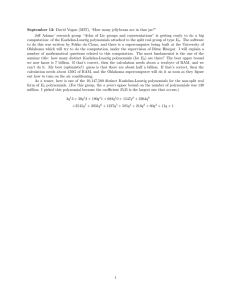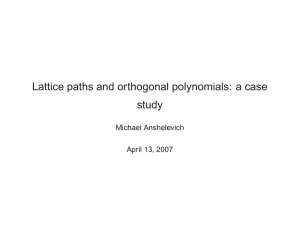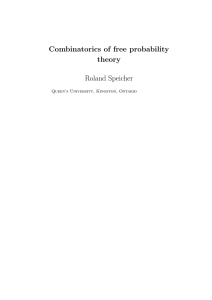Linearization coefficients, orthogonal polynomials, and free probability Michael Anshelevich February 15, 2005
advertisement
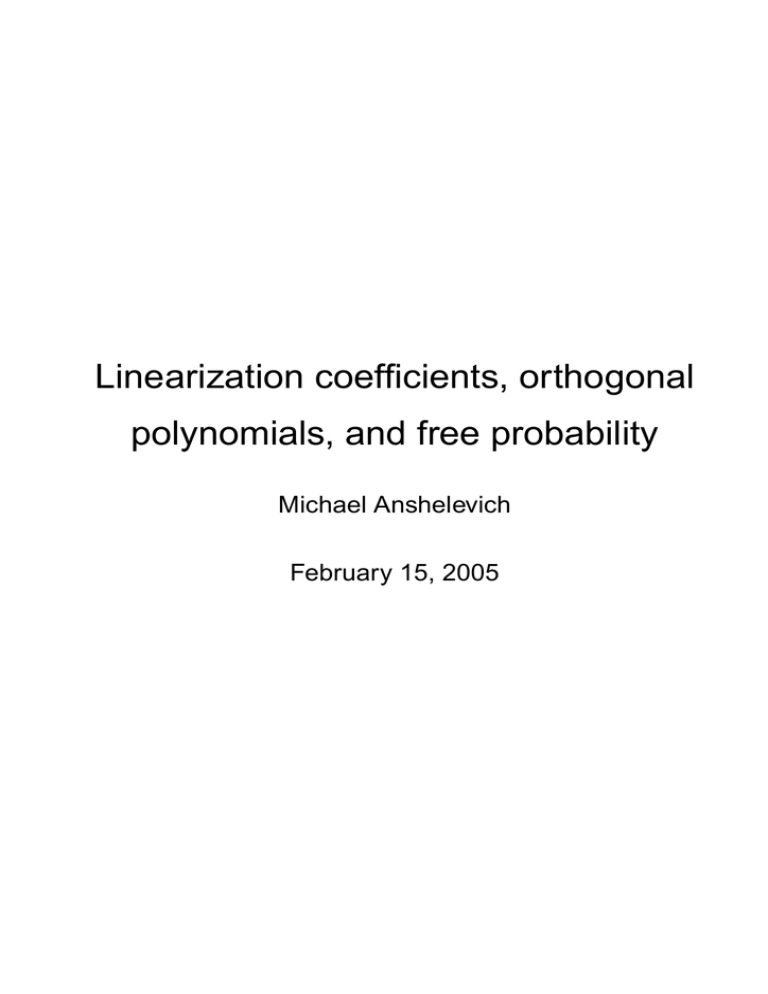
Linearization coefficients, orthogonal
polynomials, and free probability
Michael Anshelevich
February 15, 2005
{Hn(x)} = (monic) Hermite polynomials, orthogonal with
respect to the normal distribution
1 −x2/2
√
dµ(x) =
e
dx.
2π
Z
R
Hn(x) dµ(x) = δn0,
Z
R
Hn(x)Hk (x) dµ(x) = δnk n!
What is
Z
cn,k,l =
R
Hn(x)Hk (x)Hl (x) dµ(x)?
Why care:
f =
X
anHn,
g=
X
bk Hk ;
fg =
X
·Hl .
n+k
X
1
Hn Hk =
cn,k,l Hl .
l!
l=0
1
Linearization coefficients.
Answer: positive integers!
³
´ ³ n!k!l!´ ³
´ ,
n+k−l
n+l−k
k+l−n
!
!
!
2
2
2
cn,k,l =
0,
n + k + l even,
n + k ≥ l,
n + l ≥ k,
k + l ≥ n,
otherwise.
Integers “count something”.
2
{Un} Chebyshev polynomials of the 2nd kind, orthogonal
with respect to the semicircle law
q
1
dµ(x) =
4 − x21[−2,2] dx.
2π
0.6
0.5
0.4
0.3
0.2
0.1
–1
–0.8
–0.6
–0.4
–0.2
0
0.2
0.6
0.4
0.8
x
Linearization coefficients are
cn,k,l =
1,
same conditions,
0, otherwise.
3
1
A very general family: {Pn,q,α(x)} continuous big q-Hermite
polynomials. Can write down the orthogonality measure
(basic hypergeometric function), easier to use the recursion relation
Pn+1 = xPn − α[n]q Pn − [n]q Pn−1,
where
[n]q = 1 + q + . . . + q n−1
are the q-integers.
α = 0, q = 1: Hermite.
α = 0, q = 0: Chebyshev.
α = 1, q = 1: Charlier (orthogonal wrt Poisson).
4
Proposition. (M.A. ’04)
cn,k,l =
X
q rc(π)αn+k+l−2|π|.
π∈P(n,k,l)
where
P(n, k, l) = inhomogeneous (n, k, l)-partitions,
rc (π ) = number of restricted crossings of π.
If α = 0, n + k + l = 2 |π|, so π = pair partition.
If q = 0, rc (π ) = 0, π = non-crossing partition.
Hermite: pair partitions.
Chebyshev: non-crossing pair partitions.
5
F REE P ROBABILITY.
Let µ, ν be two probability measures. Will define their free
convolution.
Let {Ann}∞
n=1o be n × n diagonal matrices, with diagonal
entries λi,n such that
´
1³
w
δλ1,n + δλ2,n + . . . + δλn,n −→ µ.
n
Let {Bn} similarly approximate ν.
6
Instead, let {Un} be random unitary matrices, uniformly
distributed according to Haar measure on Un.
An + UnBnUn−1 = random Hermitian matrix,
n
o
ρi,n = its random eigenvalues,
´
1³
δρ1,n + δρ2,n + . . . + δρn,n = random measure.
n
Theorem. (Voiculescu ’91, Benaych-Georges ’03) These
random measures converge almost surely to a fixed measure µ ¢ ν, the free convolution of µ and ν.
7
How to calculate it: for z ∈ C+, let
Z
1
Gµ(z) =
dµ(x)
Rz−x
be the Cauchy transform of µ. Has a local inverse with
respect to composition. Define
1
Rµ(z) =
.
z
R-transform of µ, analytic function on some domain in C.
G−1
µ (z) −
Theorem. (Bercovici, Voiculescu ’93)
Rµ¢ν (z) = Rµ(z) + Rν (z).
Can recover G from R, and µ ¢ ν from Gµ¢ν via Stieltjes
inversion formula.
8
Moreover, can calculate all mixed moments such as
·
lim tr An(UnBnUn−1)An(UnBnUn−1)2
¸
n→∞
as follows: An, UnBnUn−1 are asymptotically freely independent.
If X, Y independent, cannot have
E[XY XY ] 6= E[XXY Y ].
Definition. (Voiculescu) Operators a, b in a (von Neumann) algebra are freely independent with respect to a
state ϕ if whenever
ϕ [p1(a)] = . . . = ϕ [pn(a)] = 0,
and
ϕ [q1(b)] = . . . = ϕ [qn(b)] = 0,
then
ϕ [p1(a)q1(b) . . . pn(a)qn(b)] = 0.
9
Free probability: non-commutative probability theory, dealing with operators, based on free independence.
Freely independent operators appear in group algebras
of free groups.
Also as operators on the full Fock space.
Many parallels to the usual theory.
Many differences.
Central Limit Theorem. Let X1, X2, . . . be independent
centered random variables with common distribution µ.
Then under certain conditions on µ (variance function
slowly varying)
X1 + X2 + . . . + Xn
dist
√
n
= (µ ∗ µ ∗ . . . ∗ µ) ◦ D1/√n −→ normal distribution.
10
Central Limit Theorem. Let X1, X2, . . . be independent
centered random variables with common distribution µ.
Then under certain conditions on µ (variance function
slowly varying)
X1 + X2 + . . . + Xn
√
n
= (µ ∗ µ ∗ . . . ∗ µ) ◦ D1/√n
dist
−→ normal distribution.
Free Central Limit Theorem. Let Y1, Y2, . . . be freely independent centered operators with common distribution
µ. Then under the same conditions on µ
Y1 + Y2 + . . . + Yn
dist
√
n
= (µ ¢ µ ¢ . . . ¢ µ) ◦ D1/√n
−→ semicircular distribution.
11
D IFFERENCE .
For
1
1
µ = δ0 + δ1
2
2
Bernoulli,
µ∗µ=
1
1
1
δ0 + δ1 + δ2
4
2
4
atomic with 3 atoms.
In contrast:
µ¢µ=
q
1
π x(2 − x)
1[0,2](x) dx
absolutely continuous!
12
C OMBINATORICS .
Consider measures all of whose moments are finite.
Z
R
exz dµ(x) =
Z
mn =
R
∞
X
1
n=0 n!
mn(µ)z n,
xn dµ(x) = moments.
Have another sequence of cumulants (semi-invariants).
Yet another sequence: free cumulants
Rµ(z) =
∞
X
rnz n−1.
n=1
rn(X + Y ) = rn(X) + rn(Y )
if X, Y freely independent.
13
Combinatorial relation between moments and free cumulants:
Let π ∈ NC (n) be a non-crossing partition of the set of
n elements.
rπ =
Y
r|B|.
B∈π
Then (Speicher)
mn =
X
rπ .
π∈NC (n)
Similar relation for classical cumulants and all partitions.
14
Proof of the free central limit theorem (combinatorial
case):
rk (Y1 + . . . + Yn) = rk (Y1) + . . . + rk (Yn)
= nrk (Y ).
√
√ k
rk (Y / n) = rk (Y )/ n =
Thus
Ã
Y1 + Y2 + . . . + Yn
rk
√
n
!
=
1
rk (Y ).
k/2
n
1
rk (Y ),
(k−2)/2
n
so in the limit r1 = 0, r2 = r2(Y ), rk = 0 for k > 2. So
mn(µ) = #{non-crossing pair partitions}
=
0,
n odd,
n
1
n’th Catalan number
, n even.
n/2+1 n/2
³
´
Then µ = semicircle law.
15
Thus for µ = Gaussian distribution,
Z
H1H1 . . . H1 dµ = number of all pair partitions.
For µ = semicircular distribution,
Z
U1U1 . . . U1 dµ = number of non-crossing pair partitions.
How to get the higher-degree polynomials?
16
C OMBINATORIAL
STOCHASTIC MEASURES .
(Rota, Wallstrom ’97)
{X(t)} = operator-valued stochastic process, stationary
wrt ϕ [·], freely independent increments.
For a set partition π, define the stochastic measure Stπ .
π = {(1, 3, 6)(2, 4)(5)} .
1
2
3
4
5
6
Stπ (t) =
Z
[0,t)3
dX(s1)dX(s2)dX(s1)dX(s2)dX(s3)dX(s1).
17
Z
ψn(t) =
dX(s1)dX(s2) · · · dX(sn)
[0,t)n
all si ’s distinct
the usual stochastic integrals.
Precise definition of Stπ : approximate by Riemann sums.
Convergence shown under various conditions.
Proposition. (M.A. ’00)
a) Stπ exists as a limit in the operator norm.
b) If π has crossings, Stπ = 0.
18
Proposition. [Linearization ⇔ Itô formula]
k
Y
j=1
X
ψnk =
Stπ .
π∈NC (n1 ,n2 ,...,nk )
Analogy: ψn ↔ Pn. In our examples
ψn(t) = Pn(X(t), t).
Z
R
Pn(x)Pk (x)Pl (x) dµ(x) = ϕ [ψnψk ψl ]
=
X
π∈NC (n,k,l)
X
ϕ [Stπ ] =
rπ .
π∈NC (n,k,l)
For the Brownian motion,
ψn(t) = Hn(X(t), t),
Hermite polynomials.
Z
R
Hn(x)Hk (x)Hl (x) dµ(x) = |P 2(n, k, l)| .
19
For the centered Poisson process,
ψn(t) = Cn(X(t), t),
centered Charlier polynomials.
Z
R
Cn(x)Ck (x)Cl (x) dµ(x) = |P(n, k, l)| .
For the free Brownian motion,
ψn(t) = Un(X(t), t),
Chebyshev polynomials of the 2nd kind.
Z
R
Un(x)Uk (x)Ul (x) dµ(x) = |NC 2(n, k, l)| .
20
For the q-Hermite, use processes on the q-deformed full
Fock space, with a lot more work (M.A. ’01, ’05).
For the centered q-Poisson process,
ψn(t) = Pn(X(t), t),
centered continuous big q-Hermite polynomials.
Z
R
Pn(x)Pk (x)Pl (x) dµ(x) =
X
q rc(π).
π∈P(n,k,l)
21




